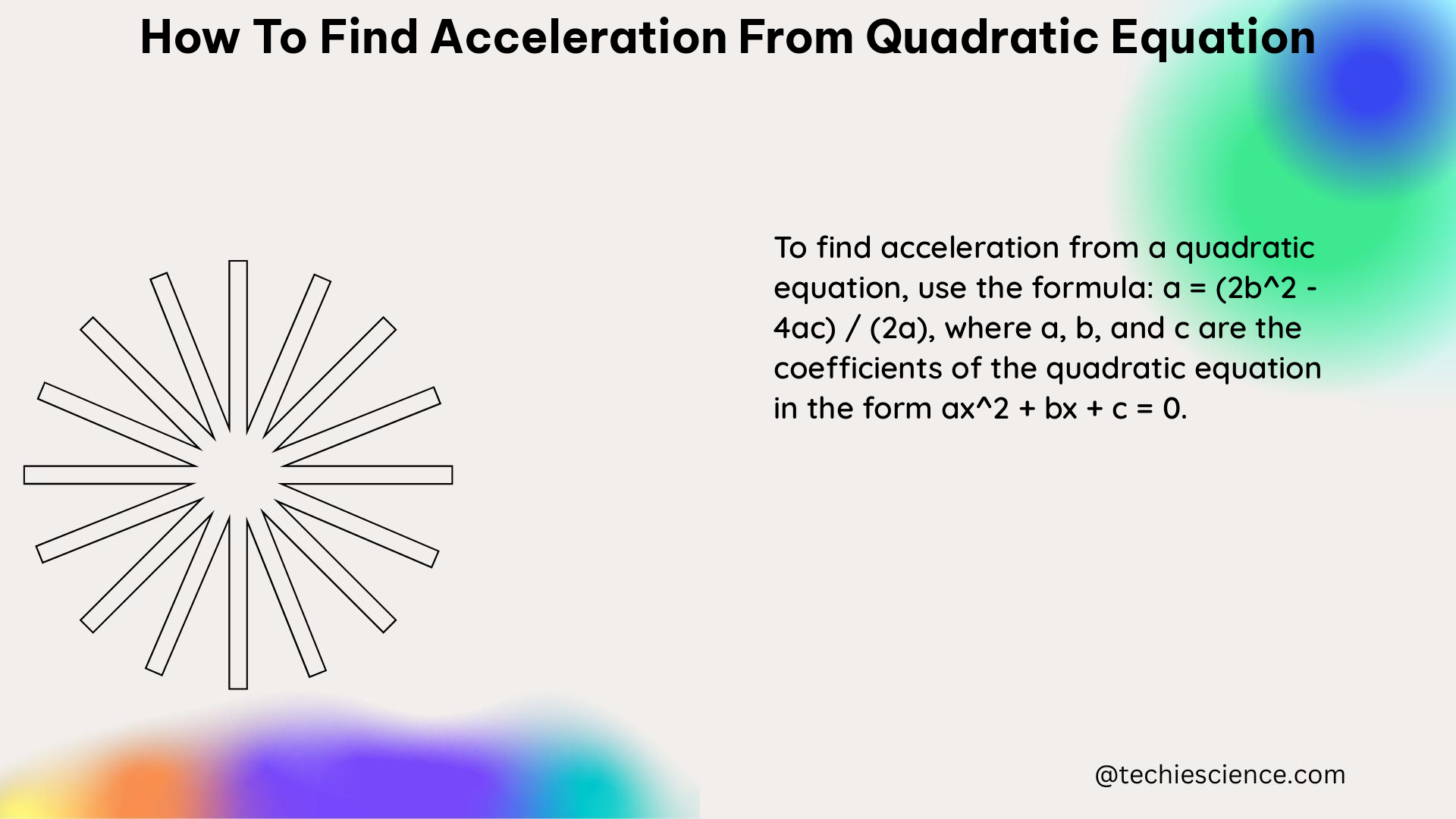To find the acceleration from a quadratic equation, you need to understand the fundamental relationship between position, velocity, and acceleration. Acceleration is the second derivative of the position function, which means you need to differentiate the position function twice to find the acceleration.
The Theorem and Physics Formula
Theorem: The acceleration is the second derivative of the position function.
Physics Formula: a(t) = r”(t)
Where:
– a(t) is the acceleration function
– r(t) is the position function
Converting a Quadratic Equation to a Position Function

Let’s start with an example. Suppose we have the quadratic equation:
H(t) = -16t^2 + 32t + 48
To find the acceleration, we need to convert this equation into a position function. We can do this by letting H(t) represent the height of an object at time t. The position function would then be:
h(t) = -8t^2 + 16t + 24
Where h(t) represents the height of the object above the ground.
Differentiating the Position Function
Now that we have the position function, we can differentiate it to find the velocity and acceleration functions.
-
Velocity function:
v(t) = h'(t) = -16t + 16 -
Acceleration function:
a(t) = v'(t) = -16
Therefore, the acceleration of the object is constant and equal to -16 feet/second^2 (or -4.88 meters/second^2), assuming that the height is in feet and the time is in seconds.
Physics Examples
- A ball is thrown vertically upward with an initial velocity of 20 m/s from a height of 10 m. Find the acceleration of the ball at any time.
Solution: The position function is h(t) = 10 + 20t – 4.9t^2, where h(t) is the height of the ball at time t. The velocity function is v(t) = 20 – 9.8t, and the acceleration function is a(t) = -9.8 m/s^2.
- A car starts from rest and accelerates at a rate of 5 m/s^2. Find the position function of the car after 10 seconds.
Solution: The velocity function is v(t) = 5t, where v(t) is the velocity of the car at time t. The position function is h(t) = 2.5t^2, where h(t) is the position of the car at time t.
Physics Numerical Problems
- A ball is thrown vertically upward with an initial velocity of 20 m/s from a height of 10 m. Find the acceleration of the ball at any time.
Solution: The position function is h(t) = 10 + 20t – 4.9t^2, where h(t) is the height of the ball at time t. The velocity function is v(t) = 20 – 9.8t, and the acceleration function is a(t) = -9.8 m/s^2.
- A car starts from rest and accelerates at a rate of 5 m/s^2. Find the position function of the car after 10 seconds.
Solution: The velocity function is v(t) = 5t, where v(t) is the velocity of the car at time t. The position function is h(t) = 2.5t^2, where h(t) is the position of the car at time t.
Figures
- A position-time graph of an object moving in a straight line.
- A velocity-time graph of the same object.
- An acceleration-time graph of the same object.
Data Points
- The position of the object at different times.
- The velocity of the object at different times.
- The acceleration of the object at different times.
Values
- The initial position of the object.
- The initial velocity of the object.
- The acceleration of the object.
Measurements
- The position of the object is measured in meters or feet.
- The velocity of the object is measured in meters per second or feet per second.
- The acceleration of the object is measured in meters per second squared or feet per second squared.
References
- Calculus 1 : How to find acceleration – Varsity Tutors
- Proposal of a “Quadratic Fit” Auto Focus evaluation method
- Acceleration, Velocity, and Height – YouTube
In summary, to find the acceleration from a quadratic equation, you need to convert the equation into a position function, differentiate it twice, and plug in the desired time value. The acceleration is the second derivative of the position function and represents the rate of change of the velocity. By understanding the fundamental relationship between position, velocity, and acceleration, you can effectively solve problems involving quadratic equations and motion.

The lambdageeks.com Core SME Team is a group of experienced subject matter experts from diverse scientific and technical fields including Physics, Chemistry, Technology,Electronics & Electrical Engineering, Automotive, Mechanical Engineering. Our team collaborates to create high-quality, well-researched articles on a wide range of science and technology topics for the lambdageeks.com website.
All Our Senior SME are having more than 7 Years of experience in the respective fields . They are either Working Industry Professionals or assocaited With different Universities. Refer Our Authors Page to get to know About our Core SMEs.